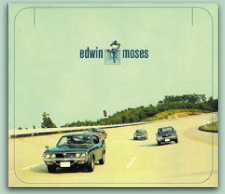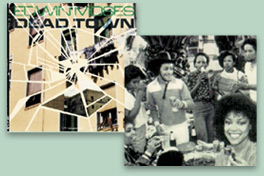records
Listen and read all about EM evolution. Select a LP picture and enjoy it!!!
LP
records


Though this original Edwin Moses' trademark was kind of a game to mislead a little bit, the extent and the impact of this story was much greater than expected when it was included in the first LP. Everybody asked: who are this crazy guys talking about? Edwin Moses, the musician or the athlete? The next albums solved the doubt. The trademark had to be refused.

The Moses family provided us with a lot of material, among which we have selected the picture of the party where the LP 'dead Town' (1970) was presented. This is the album covering the first releases of 'What's going down' or 'Stop Killing your sons'. The label Canyon Records strongly supported this fantastic LP.
I'll be around
I'll be around was brought to the screen by Nicolás Méndez, who has also been the director for all Edwin Moses' audio-visual material up to date. Rather tan telling a story, he's trying to catch a boy who's running away...
If you can't see the video, link www.youtube.com/watch?v=SQXvTwyFflE
Edwin Moses
Why and how did some musicians from Gijón (Spain) decide to steal the name of an obscure musician who was never mentioned in the most thorough encyclopaedias of American black music? But more importantly, why and how did they dare to record a whole album of cover versions taken from his amazing repertoire?
Pedro Vigil, Pablo Errea and Luis Navarro have the answer. They are the responsibles for this challenging enterprise. How they did the entire project evolve?: "The story begins with a name: Curtis Mayfield. Yes, believe it or not, two years ago we read about his aling health and we sent him an encouraging email to wish him a prompt recovery. We also confessed our intense admiration of his music. With the benefit of hindsight we definitely think that our message impressed him in a deep way. Maybe it was our exotic origin or his good mood. In any case he replied to us very kindly shortly after. We managed to build up a fluen electronic relationship with him! Well, we even requested his advice to find suitable covers to be used. Of course our secret dream was to use Curtis' unreleased or lesser known material. We confessed our obvious limitations. We are white, we have a pop background and we release our music on a pop label. We explained to him that his music was a discovery that changed our lives as did our other favourites Isaac Hayes and Marvin Gaye".
"Clever choices of material? Curtis enlightened us: Edwin Moses, one of his distinctive fellows, and certainly the most elusive character in the music business. Somebody from Curtom records, following the instructions given by Curtis, took immediate action and sent us a tape featuring 8 songs by Edwin. A laconic note stating the title and recording year of the songs was also attached. Goodness gracious! Suddenly we saw the light, we were very excited by this unprecedented and timeless listening experience. It was exactly what we wanted. We started research on his discography with the wrong idea that Edwin Moses was once famous and renowned, at leasst in the field of American black music. But that was not possible. Interestingly enough, we found no records, no articles, no references, no clues. We contacted Curtis but his health was in poor condition by that time and his mental health was deteriorating. No answer was received. The we contacted you in despair".
Right, Vigil forwarded a formal enquiry to these writers as a result of the recommendation of the Siesta crew. Edwin Moses? Wait and see.
After examining our files we had to exhibit a similar reaction. Edwin Moses was a complete mistery. Our collector's pride was seriously damaged and we had to implement further research. The initial failure even increased our zeal and strong interest in this enigmatic musician. The search was exciting and challenging indeed for its difficulty and absurdity. First hints were obtained from browsing the internet. At least we could confirm that he released some records in the past. A friendly collector pal provided us with huge bi-annual catalogues issued by the most relevant shop in black music. Interminable lists of references. We came to the following conclussions: a) there is a high number of ostracized soul-funk musicians, and b) at a reasonable price there was an original record by Edwin Moses from 1971. Instantly we called the staff of this American shop to get hold of the precious copy but much to our dismay it had been sold. We got very frustrated. Affter some insistence we persuaded the puzzled shop assistant to let us know the name and address of the person who overtook us. We wrote a moving letter to the new owner of the record -a reputed German collector- with a 'mayday call' to save us from the debacle. Of course he did not accept the trade nor did he agree to lend out the record. However he sent us a copy of the sleee and the tracklisting. He also attached the phone number of a talent scout that treasured another EM title. Little by little -by courtesy of the big names in the international collectors scene- we got hold of acetates, photographs and graphics of EM and revealing statements by acquaintances such as his first wife Margie Moses (to whom we owe the existence of this article). Do you believe fairies exist? A collector's dream became a reality. This is the true story of Edwin Moses.
Edwin Moses was born in 1941 (Chicago, Illinois). During his childhood he resided to the popular Regal Theater, one of the shrines of black music. In his adolescence he made acquaintance with celebrities such as Major Lance, Curtis Mayfield or Jerry Butler.
By the mid fifties, Edwin Moses established camaraderie with Swamp Dogg. When he was ready to record his debut single on the legendary Nashboro label, a strange disease made him remain in bed during the sessions. The unlucky man declined any invitation to record at that time and spent the sixties gravitating aimlessly to his inevitable destination: suburban venues. He was also paying the expensive aftermath of two divorces and a jail sentence for beating a white cop. Still this man who saw himself (in his own words) as “a rebel who plays by his own rules\x94 was eager to prosper but luck was never on his way.
Moses career took a new turn at the beginning of the seventies when soul was turning funk and names such as Marvin Gaye, Donny Hathaway or Curtis Mayfield wrote wonderful songs about black resistance with powerful social conscience. Edwin Moses was surrounded by similarly free spirits and released the seminal album Dead Town (1970) on Canyon, one of the greatest underground records of funk. After the unexpected failure of Dead Town, Moses left the music scene and started a venue in San Francisco, where he had previously shared lysergic experiences with Sly Stone and Arthur Lee. In the late seventies his dreams of big-time success suddenly blurred from his mind and Edwin became a faithful Muslim and fled to make a pilgrimage to Mecca.
By LUIS LAPUENTE Y JOS\xC9 A. CASTILLO
Songs
- I needed you


- what's going down

- I'll be around

- black blood theme

- stop killing your sons


- help me

- give it a chance

- let me get inside


- let it shine

- new morning

- masterpiece
Credits
Band: Pedro Vigil, Pablo Errea, Luigi Navarro, Guzmán Argüello, Manuel Molina, Oscar Camacho, César Latorre, The Strings ensemble of San Francisco
Produced by: Paco Loco & Edwin Moses. Recorded at Odds (Gijón) and La Kaleta (Cádiz)
Design: 451




